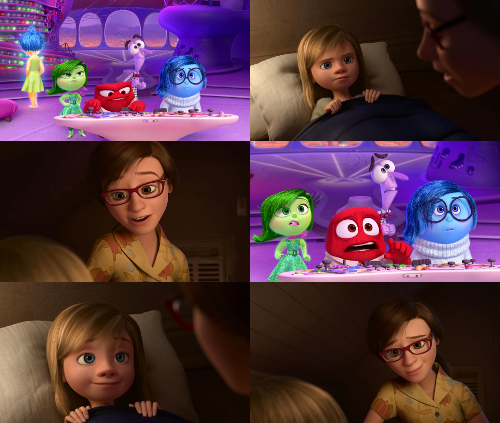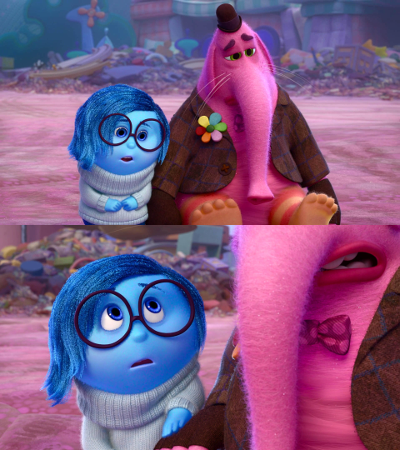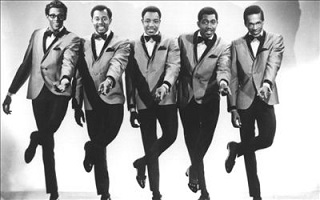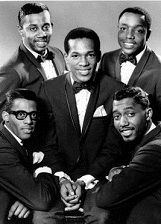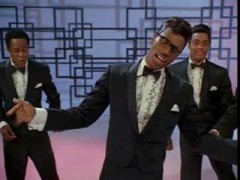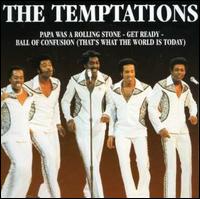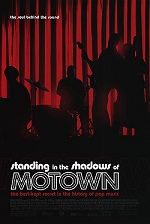The Destigmatization of Sadness in Inside Out
I’m giving Disney/Pixar an A in mental health awareness for their recent work. It seems like this is their pet topic these days, with Inside Out being the third movie running to tackle emotional health issues. First, in Disney’s Frozen, Elsa’s emotional issues and repression struck chords with people suffering from a wide variety of mental ails, such as depression, bipolar, and anxiety. Then in Disney’s Big Hero 6, Baymax makes it clear that his job as a healthcare robot is to attend to injuries both physical AND mental (the latter being the case with Hiro), and Pixar continues this pattern with Inside Out. Following the perspective of the well-meaning but unwise Joy, Inside Out contains a message about mental health that hinges on destigmatizing sadness and learning to appreciate its indispensable role in life.
I think my first impression of this movie is a representative starting place: When I first saw the Emotions introduced in the trailer — Joy, Sadness, Anger, Fear, and Disgust — my thought was that it was strange that there was only one positive emotion out of the bunch. “Weird,” I thought. “I wonder why these are predominantly (4 out of 5) negative emotions.”1 In a sense, my first thought that these are negative emotions was right — the other four emotions deal with / react to negative, unpleasant things in the environment (annoying things, scary things, disgusting things, etc.), and so we would just prefer to go through life not feeling them if given the choice.
However, the idea of the emotions other than Joy being negative is the exact myth that the movie aims to dispel. The beginning of the movie immediately gives them all a positive spin after each emotion is introduced. Anger helps Riley assert her space, rights, preferences. Fear keeps Riley safe from danger. Disgust keeps Riley from being poisoned, either physically or socially (i.e. keeps her away from low-quality things). It is only Sadness that the movie’s protagonist, Joy, has trouble understanding the positive side of.
Over the course of the movie, the lessons Joy learns about Sadness are ones the audience would do well to take to heart as well.
Lesson #1: There is a rational dimension to all emotions
One of the best scenes in the movie for me was the one in which Riley’s mother is able to change Riley’s mood by framing the current situation in a way where Riley’s perseverance through the difficult moving process makes the situation much more bearable for the parents, and how much they appreciate it. Before this moment, the “negative” emotions (Anger, Disgust, and Fear), like malcontent mutineers aboard Joy’s Happy Ship, were threatening to seize control from Joy, as there was just no way it was appropriate for Riley to look past all the disappointing, unpleasant, and awful recent experiences to continue to be cheerful (as she would if Joy were to have her way). However, upon hearing this speech, the three willingly give control back to Joy, saying, “Well, you can’t argue with Mom!”
As someone who has had a foul mood completely turned around by a little gesture of appreciation or a random act of kindness, I really liked this depiction of moods being able to suddenly shift despite an overwhelming amount of stress. Aside from that, though, I liked this depiction of emotions as responding to new information in the external world and able to be swayed by reason. Sometimes people depict emotion as the opposite of rationality, possibly because when we are overwhelmed by emotion, it’s hard to reason calmly. However, this is a false dichotomy because emotions not only (usually) have reasons behind them, but emotions are also influenced by the rational thoughts we think and how we conceive of the emotion. Rationality is present in emotions of all kinds.
In Riley’s mind, there is only one emotion shut out of the mood control process, and whose function Joy is not able to understand, and who does random “destructive” acts to Riley’s memories without being able to explain why she felt compelled to do so: Sadness. To all the emotions, Sadness’s actions — turning a happy memory suddenly sad, stepping up to the control panel without warning — seem random, intrusive, unwanted. But to the audience, it’s obvious what’s going on. Feeling down, Riley looks back on her happy memories, and finds (with some horror) that they’re suddenly tinged with sadness. And Sadness keeps absent-mindedly trying to take control because she senses on some level that she is needed, that her emotion is the one that makes the most sense for Riley at that moment — like sadness creeping in on the edges of someone who doesn’t want to admit that they’re sad.
This depiction of the “irrationality” of Sadness’s actions is a huge and important part of the film. When an observer (like Joy) cannot see, understand, or recognize the function/purpose/usefulness/role/reason behind the emotion of sadness, the state of being sad becomes frighteningly irrational/unreasonable/gratuitous/inscrutable/intrusive.
It is critical for Riley that Joy, over the course of the movie, realizes that Sadness has strengths and functions that make her indispensable, and reasons for her actions. The first lesson being…
Lesson #2a: Sadness is needed for empathizing
Lesson #2b: Sadness helps people move on
When Bing Bong loses his wagon, Joy tries to get him to power through or be diverted from his sadness using the techniques she knows — cheer-based techniques like pep talks, wheedling, optimism, amusement. She knows from experience that sometimes these techniques work (like in the above-mentioned scene), but this time it doesn’t. Sadness, however, empathizes with him and gets him to talk through what he’s feeling.
I like this very short video on the difference between sympathy and empathy, which almost reads like an explanation of the difference between Joy and Sadness’s technique:
Similar to what this short talk illustrates, sometimes it’s more meaningful or more helpful to someone not to offer humor, levity, or positive-thinking (or solutions), but to instead acknowledge their sadness or pain by getting on their level instead. This is one function of Sadness (and other emotions) in the movie — the ability to connect with the sadness that someone is experiencing. Each emotion can do this with their own emotion, but (for example) Joy cannot do it with other people’s sadness.
In addition, this scene hints at another function or purpose for sadness. Only after talking about his sadness is Bing Bong able to get over the loss of the wagon and move on to the next things.
I think this is also true to life. Having kept a diary since high school, the good that journaling has done me is very obvious to me. Writing an entry would let me organize my thoughts and get to the bottom of what exactly made me so upset in various situations, and after the painful experience of poking into all that was done (which pretty much involved an hour or two of crying), the productive next steps always became so clear to me. It’s difficult to figure out what course of action to take next when you don’t fully understand what’s upsetting you, so cutting that sadness short would have made it much harder to arrive at the point of clarity.
Small amounts of sadness or stress can be powered through without needing any closure, but sometimes you need to examine a sad event closely and deal with it before you feel okay with leaving it behind / moving past it / forgiving and forgetting. Suppressing it makes it smaller and less weighty, but means you still carry it everywhere.
Lesson #3a: Sadness is a plea for help
Lesson #3b: The suppression of sadness can cause mental harm
This is the biggest and final realization that Joy has about the function of Sadness.
In the pivotal scene of the movie, Joy discovers that a memory that she “won” (is joyful / yellow-colored) actually started out blue and sad. The way it was converted to a happy memory was by Riley’s parents and friends showing up to cheer her up after a failed game. Joy finally understands that Sadness’s main function is to signal to the external world that Riley needs something, that she needs support and help, that she can’t solve her problems by herself. That’s important because seeking help IS a good and sensible response to sadness and depression, and that connection (sadness -> seek help) is a good one for people to keep in mind. Pushing sadness down or trying to power through it means that you erase the external, detectable signals that you need help.
Aside from the suppression of sadness, the other issue related to the expression of sadness is that sometimes people DO express sadness, but they don’t receive support. They are dismissed, told they shouldn’t be sad, told their sadness is annoying or burdensome for other people, and so on.
And it’s true, dealing with someone else’s sadness is mentally/emotionally taxing. It very much CAN be a burden. Sometimes there’s just nothing that a particular person can do to help. People have limits. In such cases, it might be tempting to minimize or attempt to erase someone’s sadness in a lazier way by simply saying it doesn’t exist. However, this does not help the person at all, and instead makes it so they form a different connections about sadness instead — (sadness -> don’t seek help, because you won’t get it), or (sadness -> don’t be sad) — in their mind.
One thing that’s a bit odd about the Emotions in Inside Out is that it’s not clear if they are a part of Riley herself or if they have a caretaker relationship to her similar to that of a parent. Supporting the idea of emotions as sometimes-parents, Joy sometimes shows a sense of pride in Riley’s accomplishments or, when she replays a favorite memory, a nostalgic fondness for time spent “watching Riley grow up” — much closer to a parent than an ego. And like a parent/caretaker/someone who cares deeply for Riley’s wellbeing, Joy (and the other Emotions, even Sadness) hate seeing Riley sad. But it’s this (well-meaning) reluctance or determined resistance toward the idea of seeing someone you love sad that causes damage to that person.
I think that’s an important message — the attitude you hold towards emotions affects mental states. Many mental wellness handbooks start with the important step of learning to validate (acknowledge, non-judgmentally, the presence of) “negative” emotions, like sadness, embarrassment, hatred, jealousy, etc. If we can’t do this, we pathologically disrupt the function and role of sadness.
In conclusion, Inside Out contains an important message about the importance and value of the emotion sadness, by following the viewpoint and mistakes of the main character, Joy, who, with the best of intentions, tries to protect her human Riley from unhappiness, disappointment, or failure. The result of her mistreatment of Sadness, though, is Riley undergoing a severe mental breakdown. Even some of the reactions to this movie indicate a continued assumption that sadness is a “bad” emotion. Hopefully, sadness will continue to be destigmatized and be recognized as a health-promoting emotion.
[1] Of course, they’re based on Ekman’s basic six universal emotions, minus Surprise, so that’s at least one reason behind the choices… but that’s beside the point about how it’s important to question whether these emotions are actually negative!

